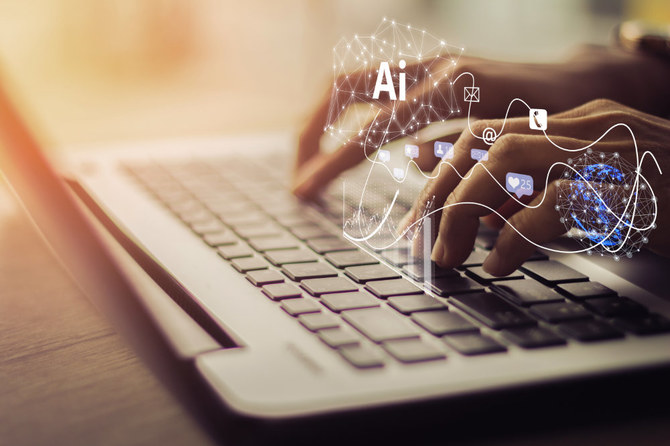
- ARAB NEWS
- 01 Aug 2025

The pursuit of intelligent machines, whether robots or potent super-computers, has been the stuff of science fiction literature for over a century. Today, the rise of artificial intelligence is rapidly turning these fantasies into reality. AI leverages the rapidly growing wealth of data around us and uses innovative technology to solve a multitude of real-world problems.
By doing this, AI is transforming entire industries at pace. Automatic pilots have been part of aviation for a long time. Anyone calling a customer service telephone number these days has a high probability of dealing with a computerized agent programmed to answer frequently asked questions. Automatic speech recognition translates human speech into a written text. AI-based image analysis uses technology to enhance human vision.
This process has delivered applications ranging from radiology to self-driving cars. Data analysis is being used to identify trends and patterns to produce recommendations. High-frequency share trading is an important application of this technology, which has also transformed advertising and customer service. An impressive validation of its potential saw AI dramatically accelerate the development of COVID-19 vaccines, which otherwise would have taken years.
The rise of AI has accelerated a long-running process of machines replacing humans in many parts of the economy, above all routine and repetitive tasks. The scope of tasks that can be automated is rapidly increasing, prompting many to worry about the future of work in general, and many specific occupations in particular.
While such fears have existed since the industrial revolution, they have been repeatedly confounded, largely because increased prosperity has thrown up new opportunities — but also because machines are not humans. Machines can replicate rational, analytical thought processes but lack emotional intelligence, intuition, and imagination.
AI reacts to data with remarkable efficiency and consistency but does not — at least not yet — typically think beyond that. It allows us to carry out various processes quickly and efficiently within a closed system but is not a tool for redesigning or re-imagining those processes, let alone for reacting to external influences or shocks. Technology can optimize standard routines but struggles to think beyond them. Despite some innovative ideas, machines are not creative. Moreover, machines do not collaborate and deliver synergies that such interaction gives rise to.
While disruptive technology is often seen as a threat, it would be much more helpful to think of AI as an opportunity for humans to do more tasks better by combining artificial and authentic intelligence in different ways.
In the same way that the first industrial revolution freed people of many laborious, repetitive, and even dangerous work, enhancing the potential benefits from division of labor, AI can free humans to do what humans do best. It is likely that much work in the future will be carried out by humans in collaboration with machines and new opportunities for human ingenuity will come from producing the most effective combinations and processes. The reality today, is that most applications of AI are examples of so-called narrow AI, designed to address particular problems or processes. Like the first industrial revolution, today’s AI technology is likely to replicate tasks, not replace entire jobs.
These qualities of AI present a particular opportunity for the Gulf region given the high labor intensity of the regional economy, perpetuated by decades of easy access to low-cost expatriate labor. By embracing technology to replace routine tasks, Gulf businesses could transition to a model where basic tasks are mechanized while more skilled employees can supervise and complement machine-driven processes.
This is not only an opportunity to move toward employment opportunities for which people can be trained. The increased use of technology can also serve as a powerful source of increased productivity and dynamism, something that would liberate regional businesses from long-standing rent-seeking practices. But leveraging technology matters not just for productivity. A failure to embrace it would create a growing gap between private businesses in the Gulf and the global frontier of business process innovation and dynamism.
AI is a powerful technology with some estimates suggesting it could add close to $16trn of value to the global economy by 2030. But like most technological innovations, it possesses the power for good and bad alike. AI processes are not necessarily infallible.
Criminal and unethical uses of AI technology abound. AI bots have been used to spread misinformation. And entire systems are vulnerable to cyberattacks. Moreover, the technology needed to power increasingly complex systems uses enormous amounts of power with potential climate risks. Through its disruptive force, AI is likely to produce winners and losers, a major concern after many years of widening income and wealth differentials around the world.
The rapid rise of AI stands in marked contrast to the global policy response to it, which has tended to be piecemeal, reactive, inconsistent, and highly divergent across regions. Most often, policymakers simply ignore this area altogether.
Yet no one can doubt the transformative power of AI. It is here to stay and continues to reshape our lives at a brisk pace. This creates an opportunity — and a need — to apply authentic intelligence to the task of understanding and, where appropriate, managing the technological transformation that is unfolding before our eyes. Properly evaluating potential risks and mitigating them not only reduces the prospect of unintended consequences. It can also be the means to unleash the power of AI to the benefit of all, not just some.
• Jarmo Kotilaine is an economist and strategist focusing on the Gulf region. He writes on issues ranging from economic development to changes within the corporate sector.